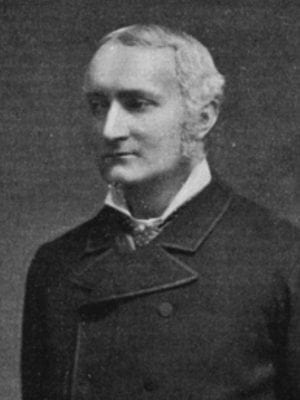William Morrant Baker
William Morrant Baker (1839 – 1896) was an English General Surgeon.
Baker lectured on physiology in St Bartholomew’s Hospital Medical School, and edited the 6th to the 13th editions of Kirke’s Physiology
Baker introduced the practice of removing the tongue in two halves (usually performed by splitting the organ longitudinally and then removing each half with an écraseur). In 1860 he invented the ‘duplex burner’ reading lamp. A metal bar residing within the long axis of the flame, just above the burner, divided the flame which burned more efficiently and provided greater illuminating power.
In 1873, under the title Erythema Serpens, Baker published the first description of Rosenbach disease (erysipeloid) an occupational skin condition secondary to infection with Erysipelothrix rhusiopathiae
Eponymously affiliated with the Baker’s cyst (1877) and the Baker’s cannula (1877)
Biography
- Born 20 October 1839
- 1858 – St Bartholomew’s Hospital Medical School
- 1861 – Resident in Midwifery and assistant to Dr West, on whose resignation, Baker was placed in temporary charge of the Maternity Department
- 1862 – Assistant to Sir James Paget (1814 – 1899) in private practice.
- 1864 – Fellow of the Royal College of Surgeons.
- 1865 – Demonstrator of anatomy and physiology, St Bartholomew’s. Fellow of Royal Medical and Chirurgical Society. Member of Pathological Society of London.
- 1869 – 1885 Lecturer in physiology and general anatomy
- 1882 – Full surgeon, St Bartholomew’s Hospital
- 1892 – Gave up surgical practice due to poor health. Elected governor of St Bartholomew’s Hospital
- Died 3 December 1896 Nutbourne Manor, Sussex
Medical Eponyms
Baker’s cyst (1877)
Baker’s paper of 1877 includes eight case reports in detail with three illustrations osteoarthritis is the underlying condition in several of the cases, in others the condition would now be called tabetic arthropathy or Charcot joints. Jean-Martin Charcot (1825-1893) had described arthropathy in 1865 but the subject had not become widely known. In 1921 Sir D’Arcy Power (1855-1941) showed that many of these cysts are part of a tuberculous affection of the joint [BJS 1921]
…in cases of effusion into the knee-joint, and especially in those in which the primary disease is osteo-arthritis, the fluid secreted may make its way out of the joint, and form by distention of neighbouring parts a synovial cyst of large or small size…the synovial cyst may be expected to disappear after a longer or shorter period, without leaving traces of its existence, even on dissection of the limb.
Baker 1877
The series of synovial cysts in connection with joints was enlarged, and the pathology was placed upon a more sound footing, by contributions to the Pathological Society of London in 1885
…abnormal synovial cysts may be formed in connection, not only with the knee, but in connection with the shoulder, the elbow, the wrist, the hip, and the ankle joints…the synovial fluid on reaching a certain amount of tension by accumulation within the joint finds its way out in the direction of least resistance, either by the channel by which some normal bursa communicates with the joint, or, by forming first a hernia of the synovial membrane. In both cases, should the tension continue or increase, the fluid at length escapes from the sac, and its boundaries are then formed only by the muscles and other tissues between and amongst which it accumulates.
Baker 1885
Baker’s cannula – a flexible tracheal/tracheotomy cannula/tube
The tube was made of ordinary India rubber, and answered the purpose for which it was intended very fairly ; but it was evident that a better material would be preferable, and the cannulae have been since constructed of vulcanized red rubber, a material which is in a high degree elastic, tough, and durable, and remains almost unaltered after long soaking in pus or other like fluids. The tube is single, and it has been found hitherto so easy of introduction and withdrawal, or , in other words, one tube can be so easily replaced by another
Baker 1877
Controversies
Sir D’Arcy Power (1855-1941) in 1921 demonstrated that the described ‘Baker’s cysts’ were often part of a tuberculous affection of joints, which had not previously been recognized by Baker. [Full Text]
Major Publications
- Baker WM. Erythema serpens. Saint Bartholomew’s Hospital Reports, London. 1873; 9: 198-211.
- Baker WM. On the formation of synovial cysts in the leg in connection with disease of the knee-joint. Saint Bartholomew’s Hospital Reports, London, 1877; 13: 245-261. [Baker’s cyst]
- Baker WM. On the Use of Flexible Tracheotomy Tubes. Medico-chirurgical transactions. 1877; LX: 71-84 [Baker’s cannula]
- Baker WM. The formation of abnormal synovial cysts in connection with the joints. II. Saint Bartholomew’s Hospital Reports, London, 1885; 21: 177-190.
- Baker WM. Hand-book of physiology. New York : W. Wood 1893
References
Biography
- South JF. Edited by Power D. Memorials of the craft of surgery in England. 1886. London: Cassell
- Obituary. William Morrant Baker, F.R.C.S. Br Med J 1896; 2: 1169
- Mostofi SB. Who’s Who in Orthopedics. Springer; 2005 edition
- Bibliography. Baker, W. Morrant. WorldCat Identities
Baker’s cyst
- Kelly EC. Baker’s cyst: formation of abnormal synovial cysts in connection with joints. Medical Classics, 1941; 5: 805-820.
- Power D. ‘Baker’s cysts’, and Baker’s tracheotomy tubes. Br J Surg, 1921; 9: 200–203.
- Rippey J. Ultrasound Case 098. LITFL
- Rippey J. Ultrasound Case 096. LITFL

